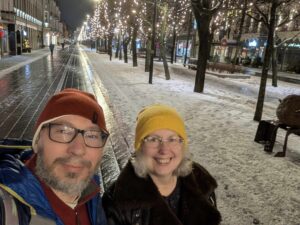 Welcome to Kaunas
Welcome to Kaunas
Welcome to Kaunas, as Writing with Labradors tackles a whole new challenge. Leaving the Peninsular War and Royal Navy behind for a short time, I’ve arrived in Lithuania as a medical tourist to get my right hip replaced.
 I’ve written before about the difficulties I’ve had getting treatment for severe osteoarthritis in my hips. After a lot of heart searching and even more research, my husband and I decided to take the plunge and go overseas for the operation. We read a lot about Lithuania, particularly the Nord Clinic in Kaunas, joined a patient group on Facebook and before Christmas we booked to make the trip, leaving Oscar and Alfie in the care of Jon, Anya and Anya’s partner Ollie.
I’ve written before about the difficulties I’ve had getting treatment for severe osteoarthritis in my hips. After a lot of heart searching and even more research, my husband and I decided to take the plunge and go overseas for the operation. We read a lot about Lithuania, particularly the Nord Clinic in Kaunas, joined a patient group on Facebook and before Christmas we booked to make the trip, leaving Oscar and Alfie in the care of Jon, Anya and Anya’s partner Ollie.
Largely because of how much worse my mobility has got over the past year, we’ve not travelled much. I had a relaxed break in Mallorca at the end of 2023 and a few short trips to visit family or to attend conferences during 2024. This trip to Kaunas hardly counts as a holiday but there was still a sense of anticipation as Christmas came and went and it was time to pack for the journey.
In the chaos of packing, organising the house and trying to get the broken central heating fixed before setting off, it didn’t occur to me I was going to be nervous, but the day before we were due to travel I unexpectedly realised I was absolutely terrified. It suddenly seemed insane that I was about to set off to a country I’d never visited to have a major operation. No matter how much I’d read about the excellent record and glowing testimonials for the Nord Clinic I wanted to cancel the whole thing and go back to bed. My poor husband patiently talked me down from my panic, soothed my tearful moments and reminded me how much better my life would get when I could walk my dogs on the beach or in the forest again.
Travelling off island in winter is always a slightly risky proposition and we watched the weather reports with growing concern as snow and ice were predicted. This is seldom too much of a problem on the island but it’s a different matter in the UK and on Sunday morning we woke to news that whole areas of the UK had been affected and that Liverpool airport was temporarily closed while they tried to clear the runways and de-ice the plane. We went to Ronaldsway and waited, stress rising as the flight was delayed, then delayed again. We were due to stay overnight in Liverpool but if we didn’t make it that day we would miss our connecting flight on Monday to Kaunas and the whole thing would have to be rearranged.
 A day of stress, virtually no food and complete exhaustion ended with us collapsing into bed in the Liverpool Airport Premier Inn. We got to the airport so late that it was closed and the passenger assistance we had booked completely failed, leaving us stranded on the plane. I’d like to give a heartfelt shout out to the EasyJet pilot, Mark. It wasn’t his job to wait behind with us, to chase up a man with a wheelchair or to personally help Richard to get me down the icy steps from the plane. He then went off to track down our checked-in luggage and escorted us to the taxi rank to make sure I was okay. That man went well beyond the call of duty and I’ll never forget how kind he was.
A day of stress, virtually no food and complete exhaustion ended with us collapsing into bed in the Liverpool Airport Premier Inn. We got to the airport so late that it was closed and the passenger assistance we had booked completely failed, leaving us stranded on the plane. I’d like to give a heartfelt shout out to the EasyJet pilot, Mark. It wasn’t his job to wait behind with us, to chase up a man with a wheelchair or to personally help Richard to get me down the icy steps from the plane. He then went off to track down our checked-in luggage and escorted us to the taxi rank to make sure I was okay. That man went well beyond the call of duty and I’ll never forget how kind he was.
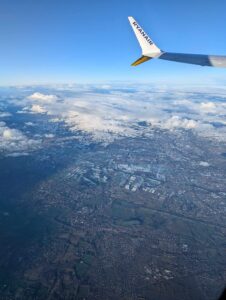 Things went much better the following day and we arrived in a snowy Kaunas to be met by the Nord Clinic driver who took us to the Hotel Kaunas. Fear of not making it in time was now replaced by fear of something going wrong with the pre-operation check-up which would prevent me having the surgery. I have no idea why I thought this might be an issue. Apart from the arthritis I’m in excellent health, very seldom get so much as a cold and had no reason to think that had suddenly changed. It turns out that pre-battle nerves can take some strange forms.
Things went much better the following day and we arrived in a snowy Kaunas to be met by the Nord Clinic driver who took us to the Hotel Kaunas. Fear of not making it in time was now replaced by fear of something going wrong with the pre-operation check-up which would prevent me having the surgery. I have no idea why I thought this might be an issue. Apart from the arthritis I’m in excellent health, very seldom get so much as a cold and had no reason to think that had suddenly changed. It turns out that pre-battle nerves can take some strange forms.
Fortunately my fears turned out to be as unnecessary as my patient husband had said they would be. All was well at the clinic this morning and with the knowledge that the surgery can go ahead, along with my first experience of the kindness and professionalism of the Nord Clinic staff, my mood improved significantly. Suddenly I realised I was in a new city, the snow had mostly gone, though it was cold and drizzling rain and I wanted to go out.
Richard made faint murmuring sounds about whether it was wise to go for a walk when the pavements are still covered in slush and I forgot to bring my walking stick from home. He didn’t really argue for long though. I’d spent far too long inside over the past few days, perched on uncomfortable airport seats or wedged painfully into airplane seats without enough leg room. I set off with a mission; I wanted to see the river and at least a little bit of the old town. Richard had a mission of his own which was to buy me a new walking stick before I killed myself.
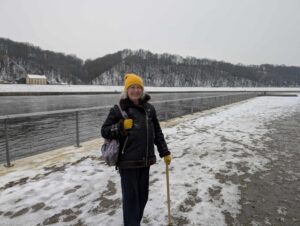 Both missions were successful. We made it down to the old town despite slightly miserable weather and once we got there, Richard gleefully spotted some rather lovely hand carved walking sticks in a shop which sold local arts and crafts. The shopkeeper helped me to test for the right size and I was delighted with my new stick, for several reasons. It will enable me to make the most of my limited visit to Kaunas before I’m laid up after the operation. It will also be a rather lovely souvenir. Finally, it made me think affectionately of my late father, who bequeathed me a fine collection of walking sticks, mainly because of the number of times he left home without his and had to buy a new one while he was away. I felt like a bit of an idiot for forgetting mine but I’m rather pleased now. I just have to make sure I don’t leave this one in the hotel room.
Both missions were successful. We made it down to the old town despite slightly miserable weather and once we got there, Richard gleefully spotted some rather lovely hand carved walking sticks in a shop which sold local arts and crafts. The shopkeeper helped me to test for the right size and I was delighted with my new stick, for several reasons. It will enable me to make the most of my limited visit to Kaunas before I’m laid up after the operation. It will also be a rather lovely souvenir. Finally, it made me think affectionately of my late father, who bequeathed me a fine collection of walking sticks, mainly because of the number of times he left home without his and had to buy a new one while he was away. I felt like a bit of an idiot for forgetting mine but I’m rather pleased now. I just have to make sure I don’t leave this one in the hotel room.
Our hotel is on the Laisvės Alėja which translates as Liberty Boulevard. It is apparently the longest pedestrian street in Eastern Europe and was mostly built in the late nineteenth and early twentieth century. On our way down to the old town we passed an open square with several statues and a memorial plaque. It looks a little bare at this time of year though I suspect it must be pretty in the summer months. The plaque tells a tragic story from a very different era to the one I’m used to reading and writing about. It is a memorial to Romas Kalanta, a 19-year-old Lithuanian student who killed himself by self-immolation in an act of protest against the Soviet regime in Lithuania.
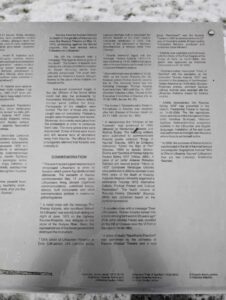 At noon on 14 May 1972, Kalanta poured three litres of petrol over himself and set himself on fire in the square in front of the Kaunas State Musical Theatre where, in 1940, a puppet legislature had declared the establishment of the Lithuanian Soviet Socialist Republic and petitioned the Soviet Union to admit Lithuania as one of the soviet socialist republics. He left a note on a bench which blamed the regime for his death. Kalanta’s suicide. His death provoked a wave of anti-Soviet public demonstrations throughout 1972 and 1973 including 13 other suicides by fire.
At noon on 14 May 1972, Kalanta poured three litres of petrol over himself and set himself on fire in the square in front of the Kaunas State Musical Theatre where, in 1940, a puppet legislature had declared the establishment of the Lithuanian Soviet Socialist Republic and petitioned the Soviet Union to admit Lithuania as one of the soviet socialist republics. He left a note on a bench which blamed the regime for his death. Kalanta’s suicide. His death provoked a wave of anti-Soviet public demonstrations throughout 1972 and 1973 including 13 other suicides by fire.
I’d done a little reading about the history of Lithuania before setting out on this trip, so I knew the outline of its struggle with the Soviet Union. Reading about a nineteen year old giving his life in such a horrific way brought the background sharply into focus. As always, it’s the story of individuals that makes history real for me and this was such a sad one.
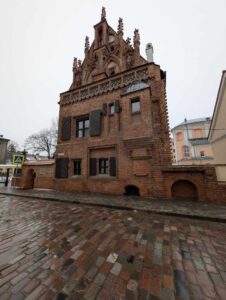 There are some lovely buildings in the old town, though slippery streets and some major building work meant I was cautious about exploring as much as I wanted to. I really took a liking to this particular house though. It’s known as the House of Perkunas which means the House of Thunder and was named after a sculpture of the god Perkunas which was found in the house during some renovations in 1818. The house was built at the end of the fifteenth century by a wealthy townsman and was later the home of a famous Jesuit historian. In 1844 the first drama theatre in Kaunas was established there. In 1991 it was returned to the Jesuits and is now used for educational purposes as well as housing a museum dedicated to the poet Adam Mickiewicz.
There are some lovely buildings in the old town, though slippery streets and some major building work meant I was cautious about exploring as much as I wanted to. I really took a liking to this particular house though. It’s known as the House of Perkunas which means the House of Thunder and was named after a sculpture of the god Perkunas which was found in the house during some renovations in 1818. The house was built at the end of the fifteenth century by a wealthy townsman and was later the home of a famous Jesuit historian. In 1844 the first drama theatre in Kaunas was established there. In 1991 it was returned to the Jesuits and is now used for educational purposes as well as housing a museum dedicated to the poet Adam Mickiewicz.
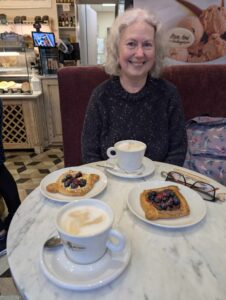 By the time I staggered back to the hotel I was in some pain, though delighted with myself for walking so far. We rewarded ourselves with coffee and pastries in the coffee shop next to the hotel. Being restricted in what I can do and where I can go has been a big problem for me and I was pleased to have seen even a little bit of Kaunas. I have a whole day tomorrow and if the weather allows and I feel up to it, I’m hoping to walk over to the castle and get in a tiny bit of history tourism to go along with my medical tourism.
By the time I staggered back to the hotel I was in some pain, though delighted with myself for walking so far. We rewarded ourselves with coffee and pastries in the coffee shop next to the hotel. Being restricted in what I can do and where I can go has been a big problem for me and I was pleased to have seen even a little bit of Kaunas. I have a whole day tomorrow and if the weather allows and I feel up to it, I’m hoping to walk over to the castle and get in a tiny bit of history tourism to go along with my medical tourism.
We found a lovely restaurant last night, called the Wood Fired Kitchen. It’s directly opposite our hotel and given its extensive menu, nice atmosphere and good beer we’ve decided not to be too adventurous with eating out and to go back there. It’s tempting to feel I should explore but this week I’m happy with familiarity. I’ve been very impressed so far with how friendly the people of Kaunas have been. Many of them speak some English and I’ve found them very welcoming and helpful.
Thanks to everyone who has sent me good luck messages over the past few weeks. I’ll keep everybody updated with how things are going and hopefully, with how work is progressing while I’m convalescing. After all, there are always stories to be written.
Signing off for today from Writing with Labradors does Lithuania. Looking forward to a new hip and some new adventures once this operation is done.

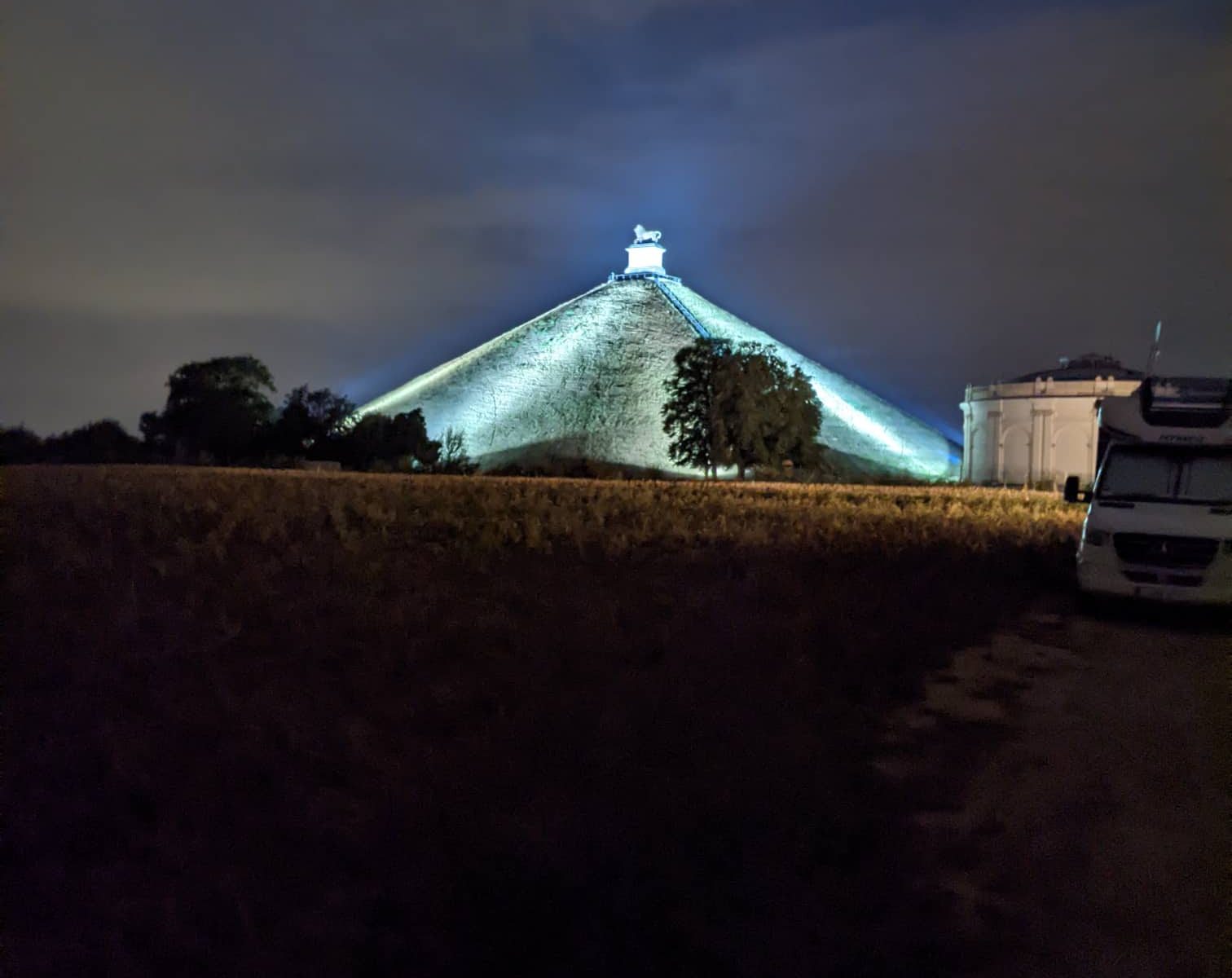
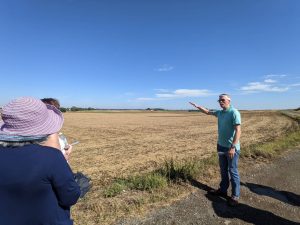
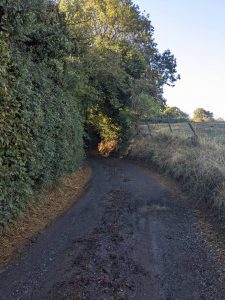 Number One London Tours
Number One London Tours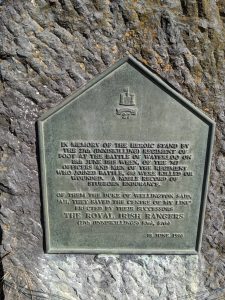 Features of the landscape like the covered way which is still partly visible, waist and head-high crops and surprisingly steep ridges help the story of the battle unfold far more easily than looking at maps. Gareth had maps a plenty though, to demonstrate each stage of the fighting as we reached it, starting from Papelotte and moving around the various parts of the field. He had also brought a copy of his fantastic
Features of the landscape like the covered way which is still partly visible, waist and head-high crops and surprisingly steep ridges help the story of the battle unfold far more easily than looking at maps. Gareth had maps a plenty though, to demonstrate each stage of the fighting as we reached it, starting from Papelotte and moving around the various parts of the field. He had also brought a copy of his fantastic Interspersed with clear, easy to understand descriptions of troop movements and the various attacks at different stages of the battle, were the individual stories from both Gareth and Kristine about the men who fought, suffered and died at Waterloo. I’ve seen many of these accounts before but hearing them read out on the ground where the action took place gave them a whole new meaning.
Interspersed with clear, easy to understand descriptions of troop movements and the various attacks at different stages of the battle, were the individual stories from both Gareth and Kristine about the men who fought, suffered and died at Waterloo. I’ve seen many of these accounts before but hearing them read out on the ground where the action took place gave them a whole new meaning.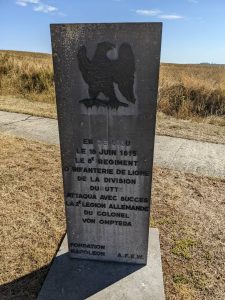 It was also horribly easy to imagine the aftermath, with dead and wounded strewn across the field. Injured men staggered towards anywhere they might find help and too many of them fell by the wayside. The memorials to the different armies and regiments as well as to a few individuals which are scattered around the battlefield highlight the poignant truth that most men who died at Waterloo had no marked grave, no memorial and quite possibly may not even have been buried at all.
It was also horribly easy to imagine the aftermath, with dead and wounded strewn across the field. Injured men staggered towards anywhere they might find help and too many of them fell by the wayside. The memorials to the different armies and regiments as well as to a few individuals which are scattered around the battlefield highlight the poignant truth that most men who died at Waterloo had no marked grave, no memorial and quite possibly may not even have been buried at all.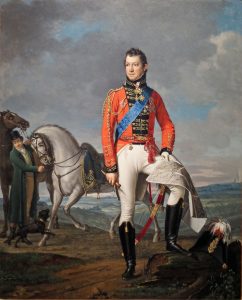
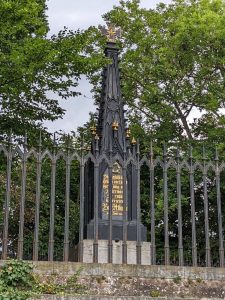
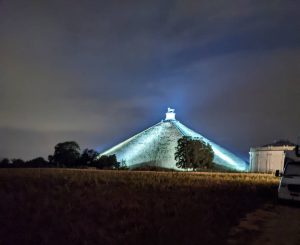 When we emerged, it was dark. Kristine had bought some flowers and a few of us walked up towards the Lion’s Mound which is lit up at night. It looked spectacular and despite all the jokes about it spoiling the battlefield, it felt like a fitting memorial that night, not to the Prince of Orange or Wellington or to any of the other individual commanders but to the thousands of anonymous men and animals who died on that field two hundred and seven years ago.
When we emerged, it was dark. Kristine had bought some flowers and a few of us walked up towards the Lion’s Mound which is lit up at night. It looked spectacular and despite all the jokes about it spoiling the battlefield, it felt like a fitting memorial that night, not to the Prince of Orange or Wellington or to any of the other individual commanders but to the thousands of anonymous men and animals who died on that field two hundred and seven years ago. 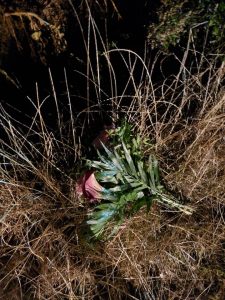 We placed the flowers on the edge of the field, not on any particular monument but just on a spot where any man might have fallen and stood quietly, listening on a phone to John Tams singing Spanish Ladies, a haunting folk song. A version of that song existed in 1815 and might have been sung by the campfires by men who did not survive that day. It seemed an appropriate memorial to the ordinary soldiers and the perfect way to end Waterloo 2022: the Battlefield Tour.
We placed the flowers on the edge of the field, not on any particular monument but just on a spot where any man might have fallen and stood quietly, listening on a phone to John Tams singing Spanish Ladies, a haunting folk song. A version of that song existed in 1815 and might have been sung by the campfires by men who did not survive that day. It seemed an appropriate memorial to the ordinary soldiers and the perfect way to end Waterloo 2022: the Battlefield Tour.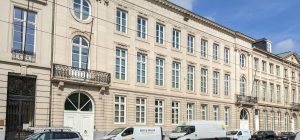
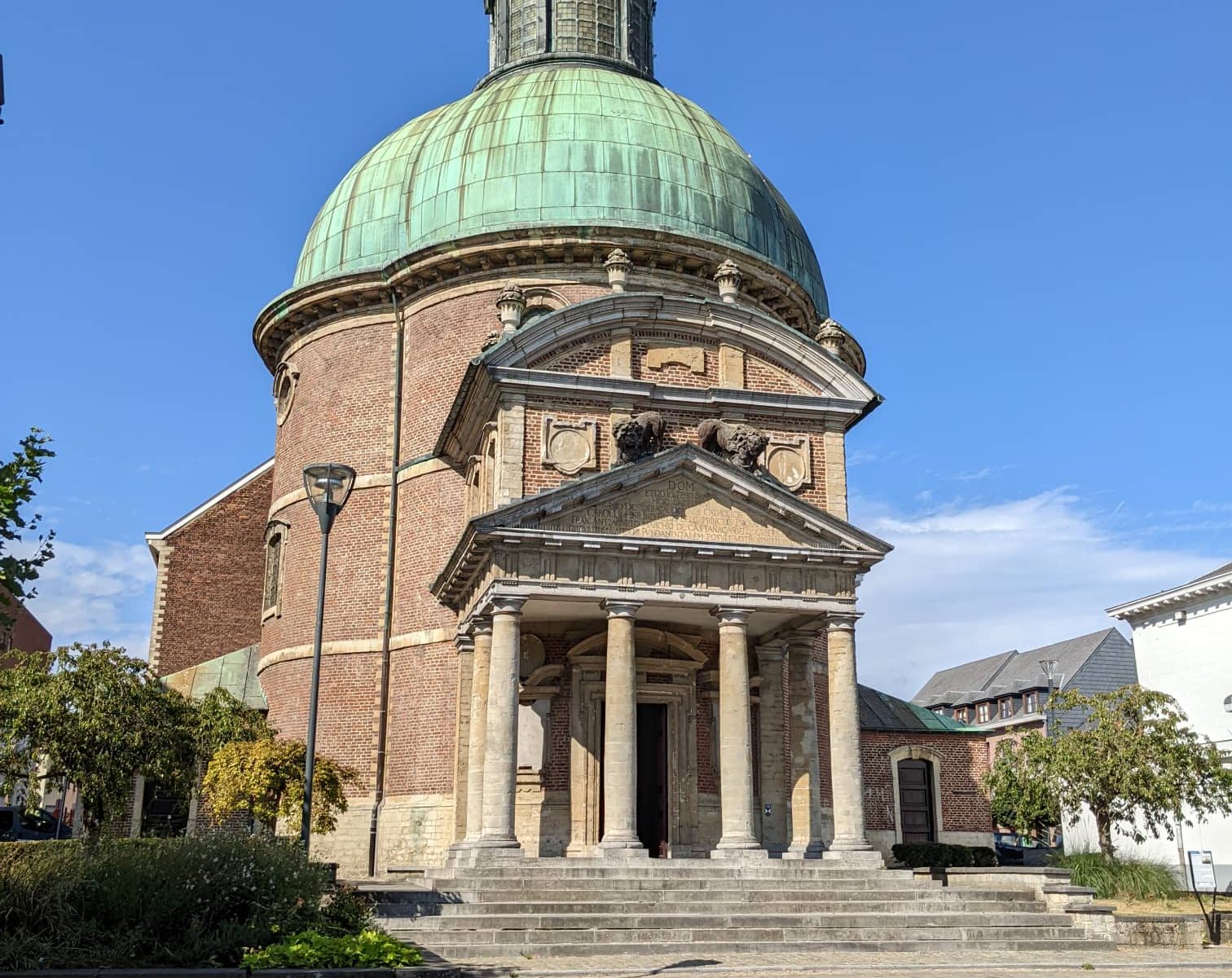
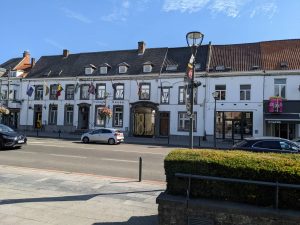
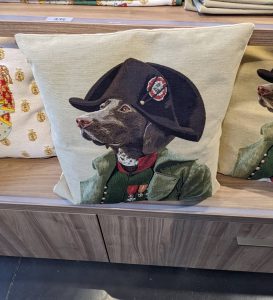 I have no idea whether there’s something political about this, whether it’s considered Napoleon was the most important person at Waterloo given that he was an Emperor or whether they just don’t think Wellington or Blucher memorabilia will sell. I do think it should probably be redressed, but if it’s a marketing decision then I guess that’s a good enough reason. All the same, Napoleon as a dog was a bit much for me.
I have no idea whether there’s something political about this, whether it’s considered Napoleon was the most important person at Waterloo given that he was an Emperor or whether they just don’t think Wellington or Blucher memorabilia will sell. I do think it should probably be redressed, but if it’s a marketing decision then I guess that’s a good enough reason. All the same, Napoleon as a dog was a bit much for me.
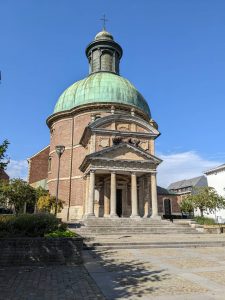 Across the busy road from the Wellington Museum is the elaborate church which was there at the time of the battle and used, like many churches, as a hospital to receive wounded men. Those of you who have followed me for a while know that I have a thing about old churches and this one was particularly peaceful, with a number of memorials to the men who fought and died during the Waterloo campaign. Memorials at this time tended to be paid for either by the family of the dead man or by subscription through the various battalions and regiments, so not surprisingly more of them relate to the wealthier regiments. Very few of the memorials even mention the NCOs and enlisted men apart from this one in the church, which may well be the first of its kind.
Across the busy road from the Wellington Museum is the elaborate church which was there at the time of the battle and used, like many churches, as a hospital to receive wounded men. Those of you who have followed me for a while know that I have a thing about old churches and this one was particularly peaceful, with a number of memorials to the men who fought and died during the Waterloo campaign. Memorials at this time tended to be paid for either by the family of the dead man or by subscription through the various battalions and regiments, so not surprisingly more of them relate to the wealthier regiments. Very few of the memorials even mention the NCOs and enlisted men apart from this one in the church, which may well be the first of its kind.
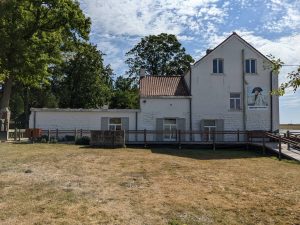 After lunch we moved on to Napoleon’s Headquarters in the farmhouse of Le Caillou, where Napoleon and his staff spent the night of June 17, 1815. The museum collection is spread over five rooms and tells the story of the Emperor’s actions in the hours before Waterloo. There are a number of artefacts relating to Napoleon, though Gareth queried whether some of the furniture was authentic given that the Prussians reputedly set fire to everything on their way through after Napoleon’s departure. Still, it gives a good sense of how the farm might have looked at the time.
After lunch we moved on to Napoleon’s Headquarters in the farmhouse of Le Caillou, where Napoleon and his staff spent the night of June 17, 1815. The museum collection is spread over five rooms and tells the story of the Emperor’s actions in the hours before Waterloo. There are a number of artefacts relating to Napoleon, though Gareth queried whether some of the furniture was authentic given that the Prussians reputedly set fire to everything on their way through after Napoleon’s departure. Still, it gives a good sense of how the farm might have looked at the time.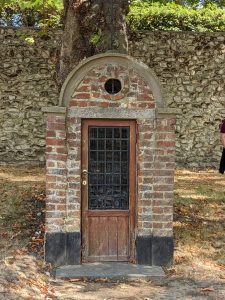 In the garden outside the farmhouse are one or two memorials. There is also an ossuary, which is a small building intended to serve as the final resting place of human bones. Ossuaries are often used where burial space is scarce but in this case it has become a depository for bones found on the battlefield over the years. I’ve seen photos of this but found the real thing unexpectedly moving.
In the garden outside the farmhouse are one or two memorials. There is also an ossuary, which is a small building intended to serve as the final resting place of human bones. Ossuaries are often used where burial space is scarce but in this case it has become a depository for bones found on the battlefield over the years. I’ve seen photos of this but found the real thing unexpectedly moving.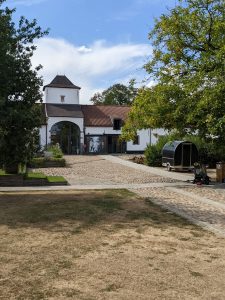
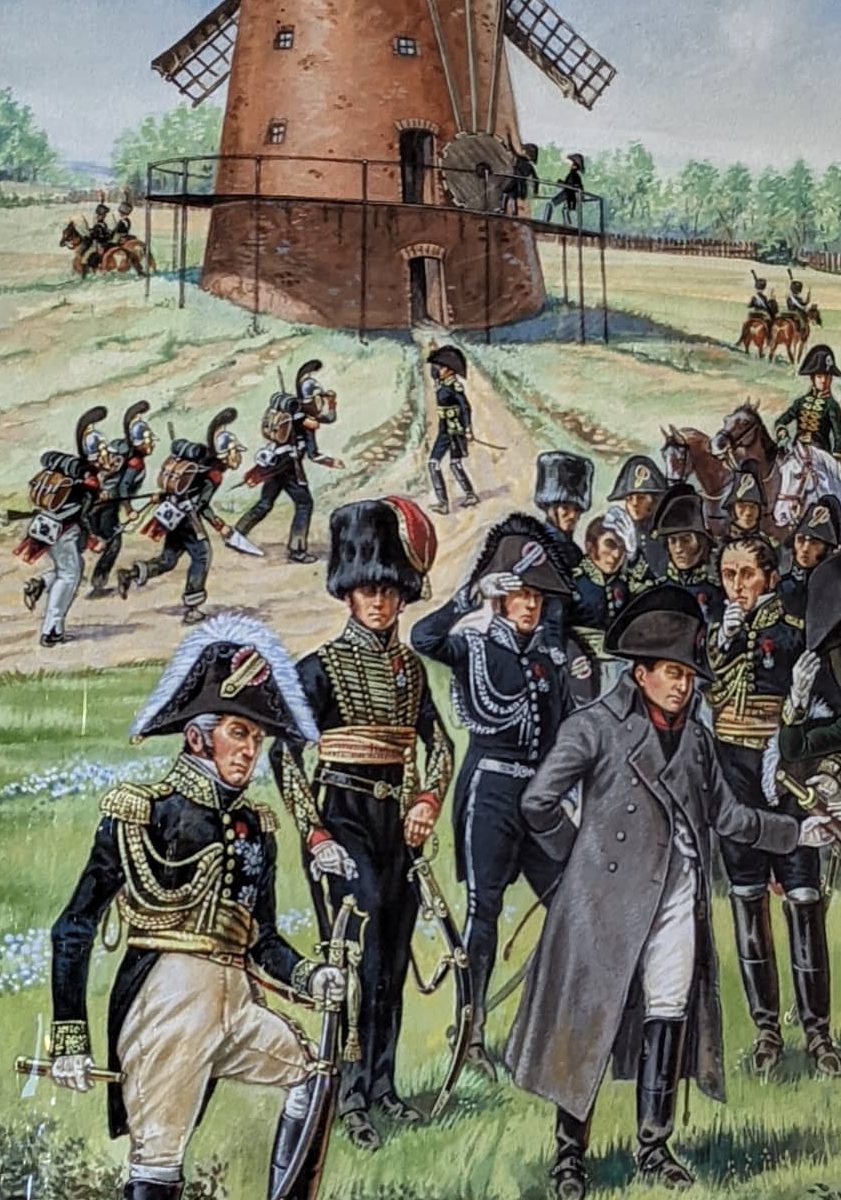

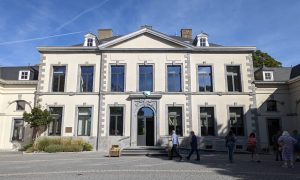
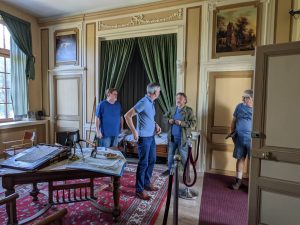
 Our next visit was to the small but very good museum in Ligny. It covers both Ligny and Quatre Bras and gave a very good sense of what happened on 16th June in these small villages and towns as the French inflicted a bloody defeat on Blucher’s Prussians and fought to a stalemate against Wellington’s Allied army. I was shocked at the extent of the casualties at both battles. Somehow I’d always had the vague impression that these were just skirmishes ahead of the main battle, but they clearly weren’t. All three armies were weakened by what happened on this day and it must have had an effect on what happened at Waterloo.
Our next visit was to the small but very good museum in Ligny. It covers both Ligny and Quatre Bras and gave a very good sense of what happened on 16th June in these small villages and towns as the French inflicted a bloody defeat on Blucher’s Prussians and fought to a stalemate against Wellington’s Allied army. I was shocked at the extent of the casualties at both battles. Somehow I’d always had the vague impression that these were just skirmishes ahead of the main battle, but they clearly weren’t. All three armies were weakened by what happened on this day and it must have had an effect on what happened at Waterloo.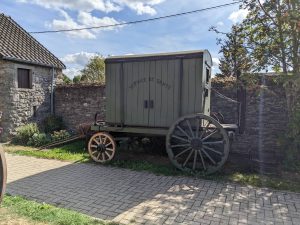
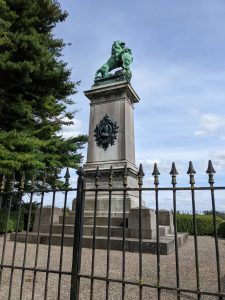
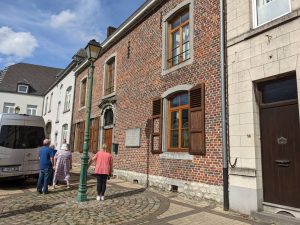
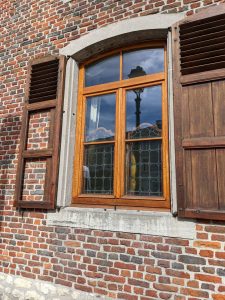
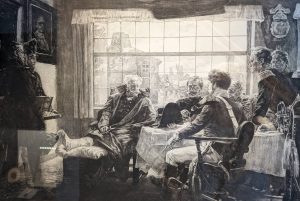
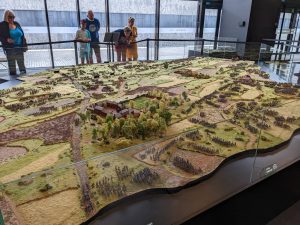 Waterloo 2022 – the Waterloo Museum and Hougoumont and we don’t hang about on the
Waterloo 2022 – the Waterloo Museum and Hougoumont and we don’t hang about on the 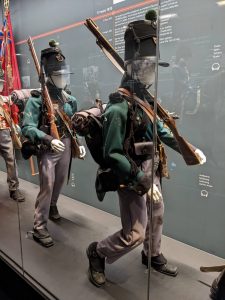 The museum gives an excellent overview of the history of the French revolution, Napoleon’s rise to power and the various coalitions and wars which led inexorably towards the Waterloo campaign. There are fabulous displays of weapons and uniforms from troops on both sides of the campaign, maps and models depicting the events of 1815 and the famous Waterloo Panorama which was painted in 1912 by Louis Dumoulin, and occupies a circular building. It is 110 metres in circumference and 12 metres high and the soundtrack plunges you into the midst of the battle. Despite, as Gareth assured us, a number of inaccuracies, it’s genuinely impressive and I’m glad we managed to see it before it closes for restoration later this month.
The museum gives an excellent overview of the history of the French revolution, Napoleon’s rise to power and the various coalitions and wars which led inexorably towards the Waterloo campaign. There are fabulous displays of weapons and uniforms from troops on both sides of the campaign, maps and models depicting the events of 1815 and the famous Waterloo Panorama which was painted in 1912 by Louis Dumoulin, and occupies a circular building. It is 110 metres in circumference and 12 metres high and the soundtrack plunges you into the midst of the battle. Despite, as Gareth assured us, a number of inaccuracies, it’s genuinely impressive and I’m glad we managed to see it before it closes for restoration later this month.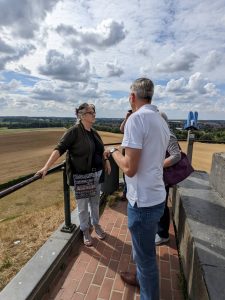
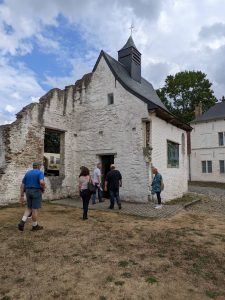
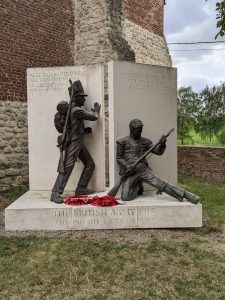
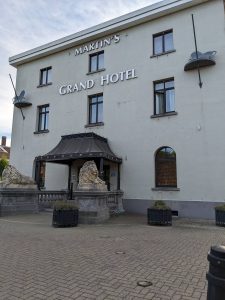
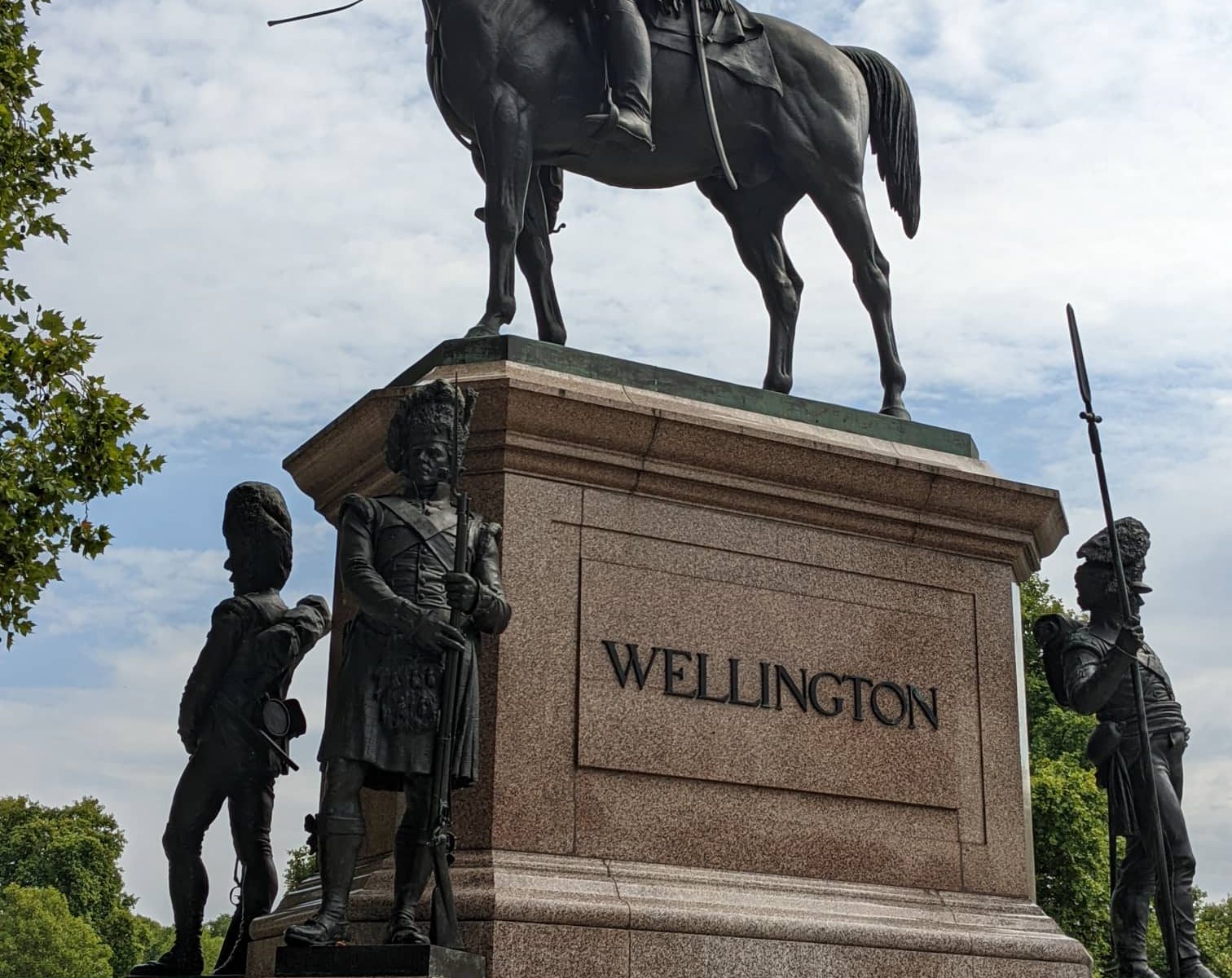
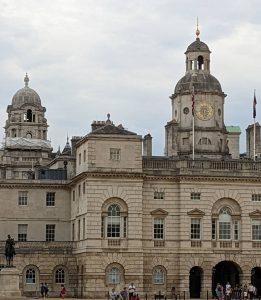
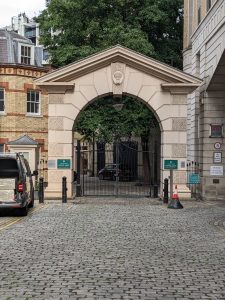
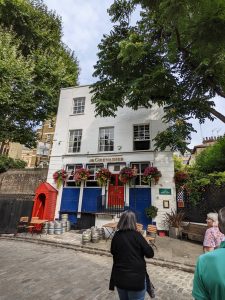
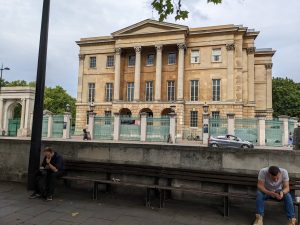
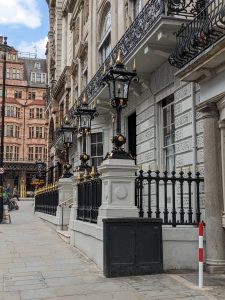
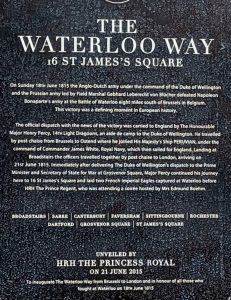
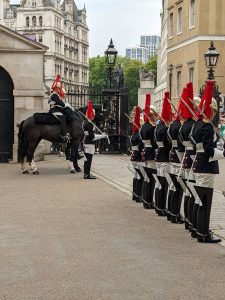 Our final stop for the day was the Horse Guards museum and were in time to see an inspection parade. After that it was back to the hotel in preparation for an early start on the Eurostar to Brussels the following morning.
Our final stop for the day was the Horse Guards museum and were in time to see an inspection parade. After that it was back to the hotel in preparation for an early start on the Eurostar to Brussels the following morning.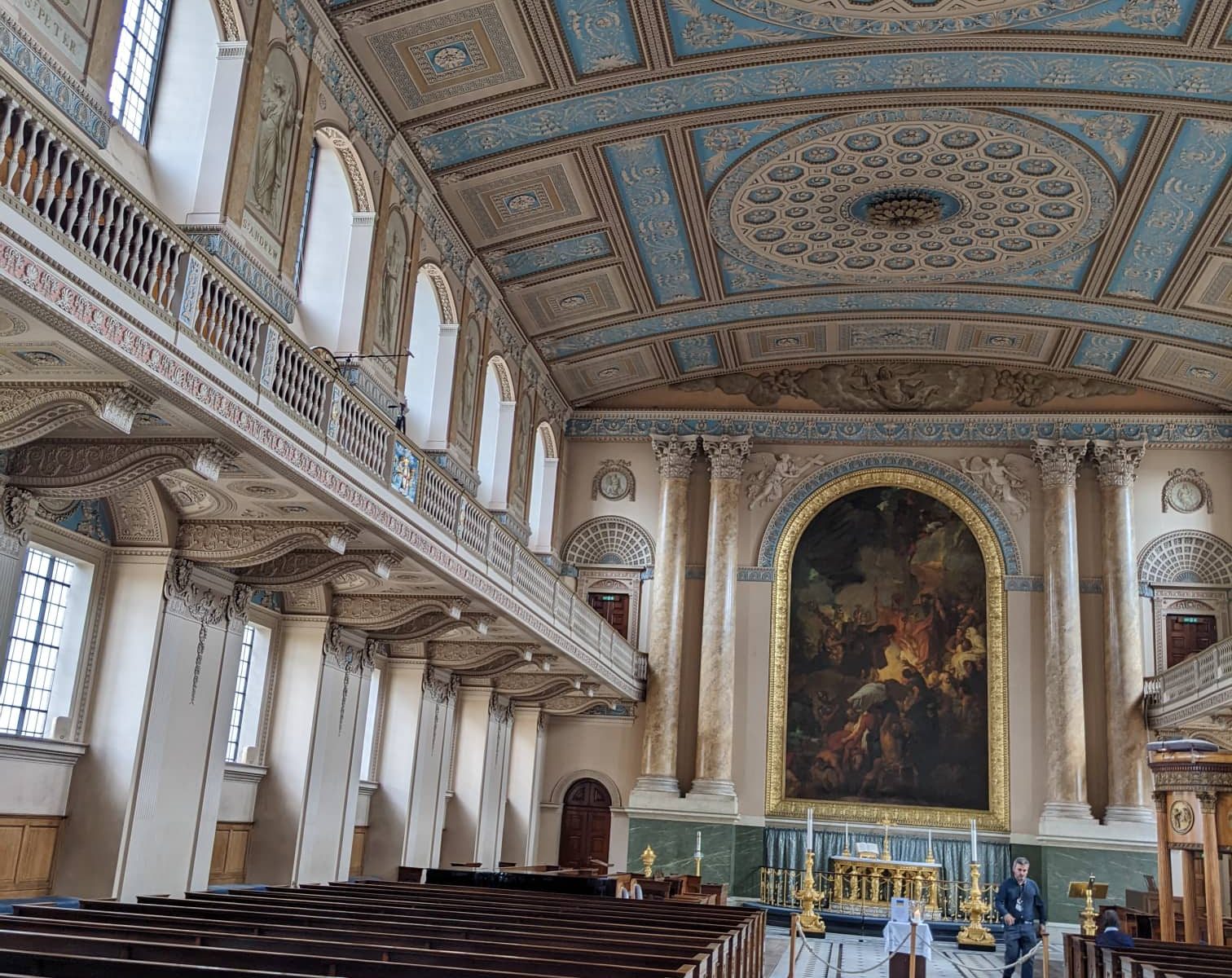
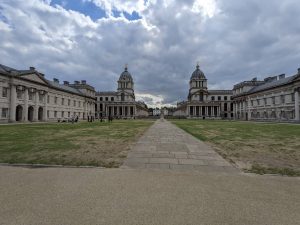 Waterloo 2022: prelude only really came about because I live on the Isle of Man. My much anticipated
Waterloo 2022: prelude only really came about because I live on the Isle of Man. My much anticipated 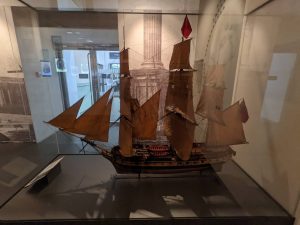 The
The 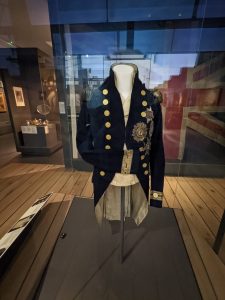 There is, as usual, an abundance of information and artefacts about Lord Nelson, England’s most feted naval hero including the clothing he was wearing when he was shot down on the deck of the Victory during the Battle of Trafalgar. While I’m grateful that the national obsession with Nelson means that EVERY navy museum has something relating to my period of interest, I can’t help imagining the howls of indignation of a few other navy officers of the era who really did some quite impressive stuff themselves, but don’t get a mention. Nevertheless, the National Maritime Museum is fascinating, with loads to see and do for both adults and children and I highly recommend it.
There is, as usual, an abundance of information and artefacts about Lord Nelson, England’s most feted naval hero including the clothing he was wearing when he was shot down on the deck of the Victory during the Battle of Trafalgar. While I’m grateful that the national obsession with Nelson means that EVERY navy museum has something relating to my period of interest, I can’t help imagining the howls of indignation of a few other navy officers of the era who really did some quite impressive stuff themselves, but don’t get a mention. Nevertheless, the National Maritime Museum is fascinating, with loads to see and do for both adults and children and I highly recommend it.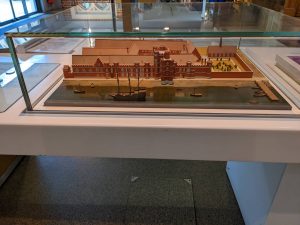
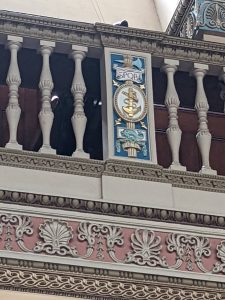 Greenwich Seaman’s Hospital was built on the orders of Mary II who was affected by the sight of wounded sailors coming home from the Battle of La Hogue. It is incredibly beautiful architecturally and both the Chapel and the Painted Hall are well worth a visit. I particularly liked the Chapel, which has naval motifs incorporated into the design.
Greenwich Seaman’s Hospital was built on the orders of Mary II who was affected by the sight of wounded sailors coming home from the Battle of La Hogue. It is incredibly beautiful architecturally and both the Chapel and the Painted Hall are well worth a visit. I particularly liked the Chapel, which has naval motifs incorporated into the design. 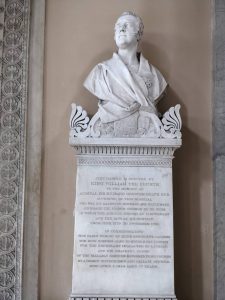
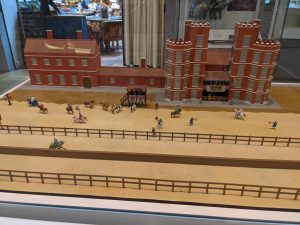
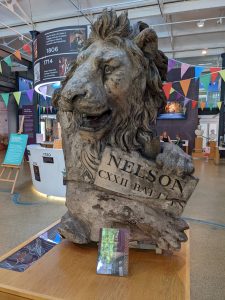 Nelson also features a fair bit, surprisingly enough. England’s Hero lay in state for several days in the Painted Hall and there is a small dedicated Nelson Room, but my favourite artefact is a lion which was apparently a model piece for the Nelson frieze. The lion is holding a stone which purports to claim that Nelson fought in 122 battles. I had this piece of information from the guide and I’ve not managed to check it at all, but my extensive reading on the subject of the Napoleonic navy so far has suggested that most of the time was spent either on tedious blockade duty or seething at home on half-pay. Nobody seemed able to answer my question about how Nelson managed to see quite so much action during his time in the navy but if I get to the bottom of it, I’ll let you know. Alternatively, if anybody else knows where I can find a list of these battles, I’d love to hear it. Nice lion, though.
Nelson also features a fair bit, surprisingly enough. England’s Hero lay in state for several days in the Painted Hall and there is a small dedicated Nelson Room, but my favourite artefact is a lion which was apparently a model piece for the Nelson frieze. The lion is holding a stone which purports to claim that Nelson fought in 122 battles. I had this piece of information from the guide and I’ve not managed to check it at all, but my extensive reading on the subject of the Napoleonic navy so far has suggested that most of the time was spent either on tedious blockade duty or seething at home on half-pay. Nobody seemed able to answer my question about how Nelson managed to see quite so much action during his time in the navy but if I get to the bottom of it, I’ll let you know. Alternatively, if anybody else knows where I can find a list of these battles, I’d love to hear it. Nice lion, though.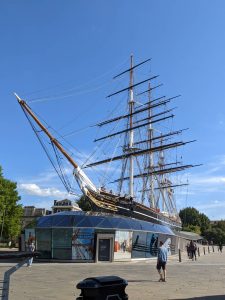 My final visit of the day was to the Cutty Sark, a nineteenth century tea clipper located in dry dock on the river bank. The Cutty Sark has a very sentimental place in my heart as it was a favourite place to visit as a child. We used to go to Greenwich a lot, getting the bus from Mile End and then walking through the Victorian foot tunnel under the river. I loved it there, the park and the eclectic market, the little shops, the Queen’s House and the Observatory, the graceful buildings of the Naval College. That much history in one place always set off my very eccentric imagination about the men and women who had lived in these buildings and walked these streets in the past. But the absolute joy for me was the once or twice a year when we were allowed to actually go aboard the Cutty Sark.
My final visit of the day was to the Cutty Sark, a nineteenth century tea clipper located in dry dock on the river bank. The Cutty Sark has a very sentimental place in my heart as it was a favourite place to visit as a child. We used to go to Greenwich a lot, getting the bus from Mile End and then walking through the Victorian foot tunnel under the river. I loved it there, the park and the eclectic market, the little shops, the Queen’s House and the Observatory, the graceful buildings of the Naval College. That much history in one place always set off my very eccentric imagination about the men and women who had lived in these buildings and walked these streets in the past. But the absolute joy for me was the once or twice a year when we were allowed to actually go aboard the Cutty Sark.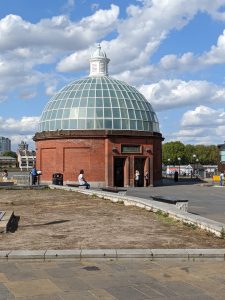
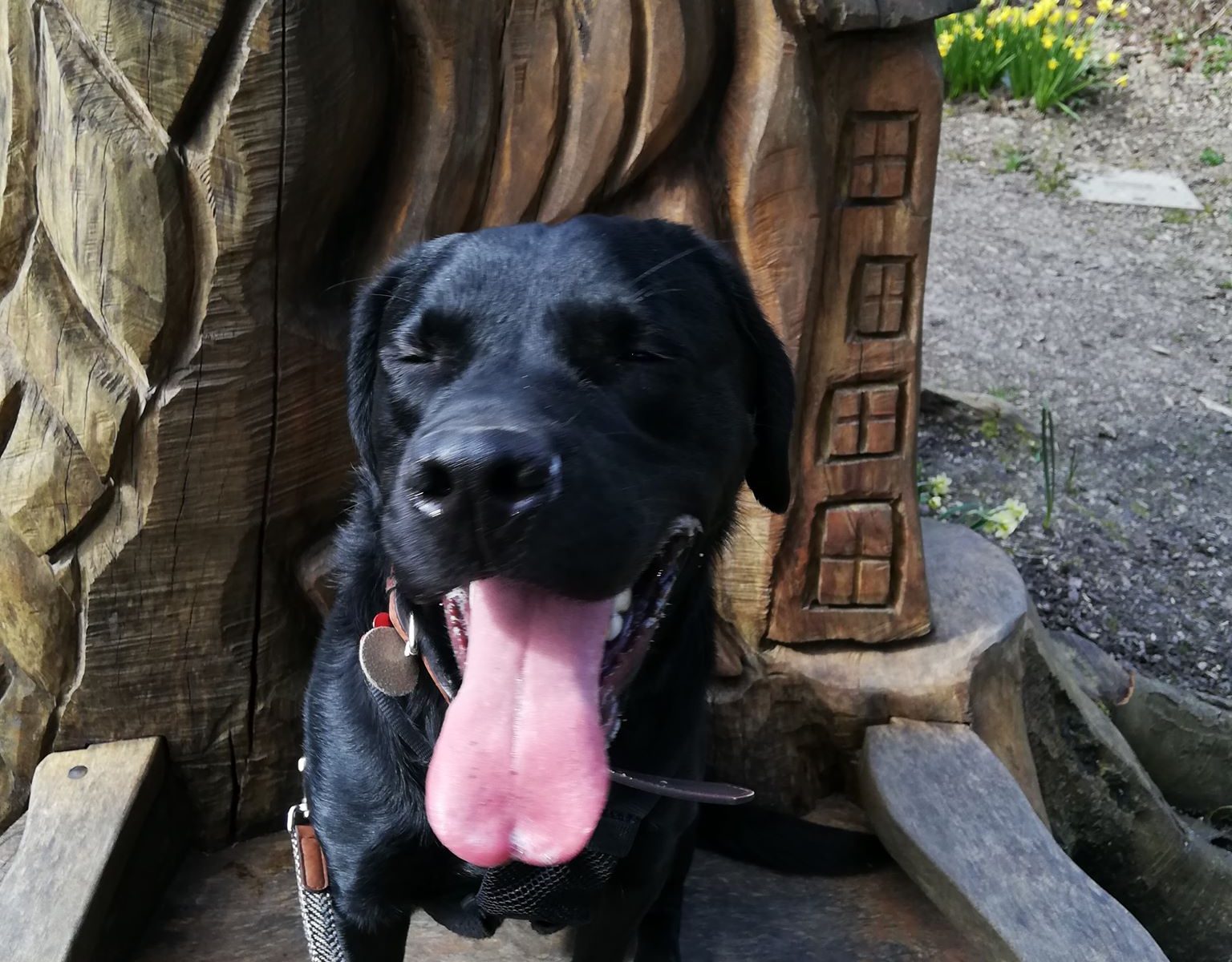
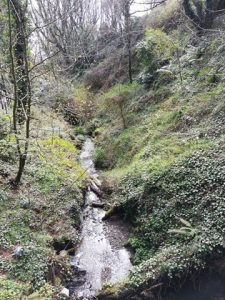 Summerhill Glen #OscarWalks is the first post Oscar and I have done for some time. We’ve been out for walks, of course, but I’ve been away a few times and Oscar had his little operation, which meant we’ve not been out and about around the island as much as we’d have liked. Needless to say, we’re going to be a bit limited for a while, but even close to home, there are some interesting places to go, and one of our favourite places for a daily walk is Summerhill Glen, which is only five minutes from our front door.
Summerhill Glen #OscarWalks is the first post Oscar and I have done for some time. We’ve been out for walks, of course, but I’ve been away a few times and Oscar had his little operation, which meant we’ve not been out and about around the island as much as we’d have liked. Needless to say, we’re going to be a bit limited for a while, but even close to home, there are some interesting places to go, and one of our favourite places for a daily walk is Summerhill Glen, which is only five minutes from our front door.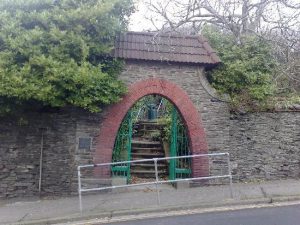 Summerhill Glen has two entrances. The top entrance is on Victoria Road near Governor’s Bridge, and the main entrance is on Summerhill, just up from Douglas Prom. It was apparently originally named Glen Crutchery. The water from the river was used to provide power to a snuff mill on Strathallan Crescent, but the mill burned to the ground in the late eighteenth century. The road became known as Burnt Mill Hill, and then later, Summerhill from a mansion house at the bottom of Blackberry Lane.
Summerhill Glen has two entrances. The top entrance is on Victoria Road near Governor’s Bridge, and the main entrance is on Summerhill, just up from Douglas Prom. It was apparently originally named Glen Crutchery. The water from the river was used to provide power to a snuff mill on Strathallan Crescent, but the mill burned to the ground in the late eighteenth century. The road became known as Burnt Mill Hill, and then later, Summerhill from a mansion house at the bottom of Blackberry Lane.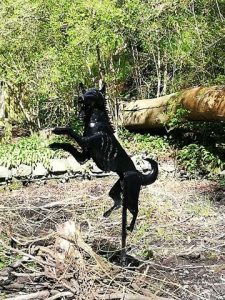 “I didn’t like the Halloween lights, Mum. That dog.”
“I didn’t like the Halloween lights, Mum. That dog.”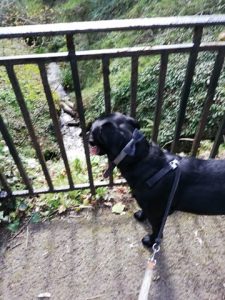 “It’s a waterfall, Oscar.”
“It’s a waterfall, Oscar.”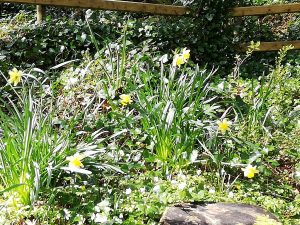 Spring is particularly lovely in the glen, with daffodils and wild flowers forming splashes of colour in the middle of the dense green of the vegetation. The main path is very good, although some of the side paths can get a bit boggy and slippery which can be an issue with an over enthusiastic labrador. Oscar has got so good on the lead now, though, that I don’t have to worry about him.
Spring is particularly lovely in the glen, with daffodils and wild flowers forming splashes of colour in the middle of the dense green of the vegetation. The main path is very good, although some of the side paths can get a bit boggy and slippery which can be an issue with an over enthusiastic labrador. Oscar has got so good on the lead now, though, that I don’t have to worry about him.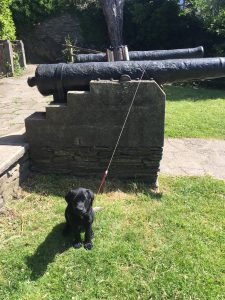
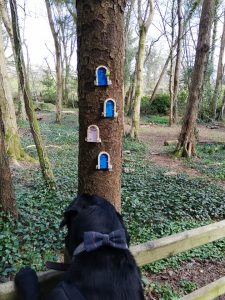
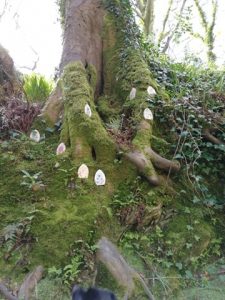 “Christmas was my favourite, it was like magic. I’m sure some of those lights looked like fairies.”
“Christmas was my favourite, it was like magic. I’m sure some of those lights looked like fairies.”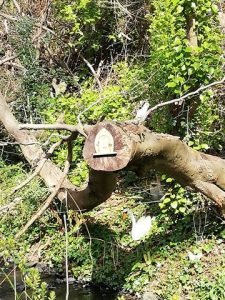
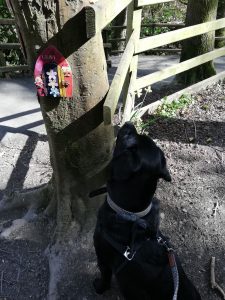
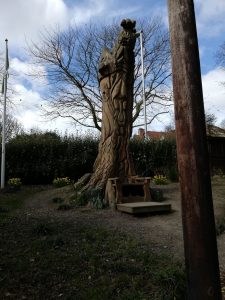
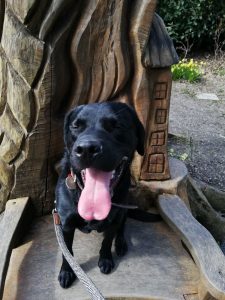
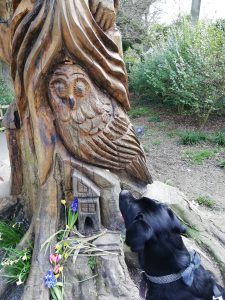
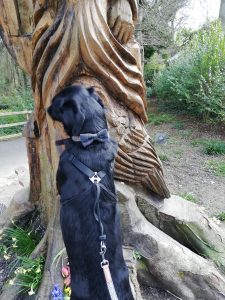
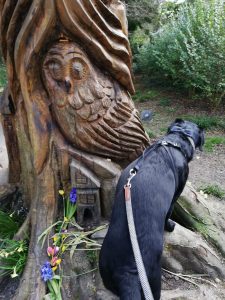
 “Sounds like a plan, Oscar.”
“Sounds like a plan, Oscar.”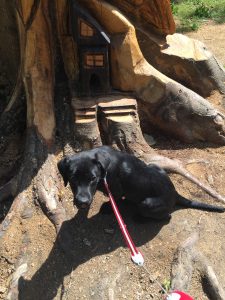
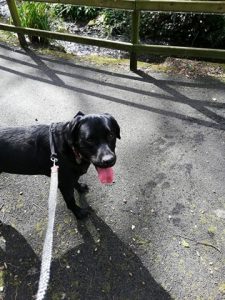
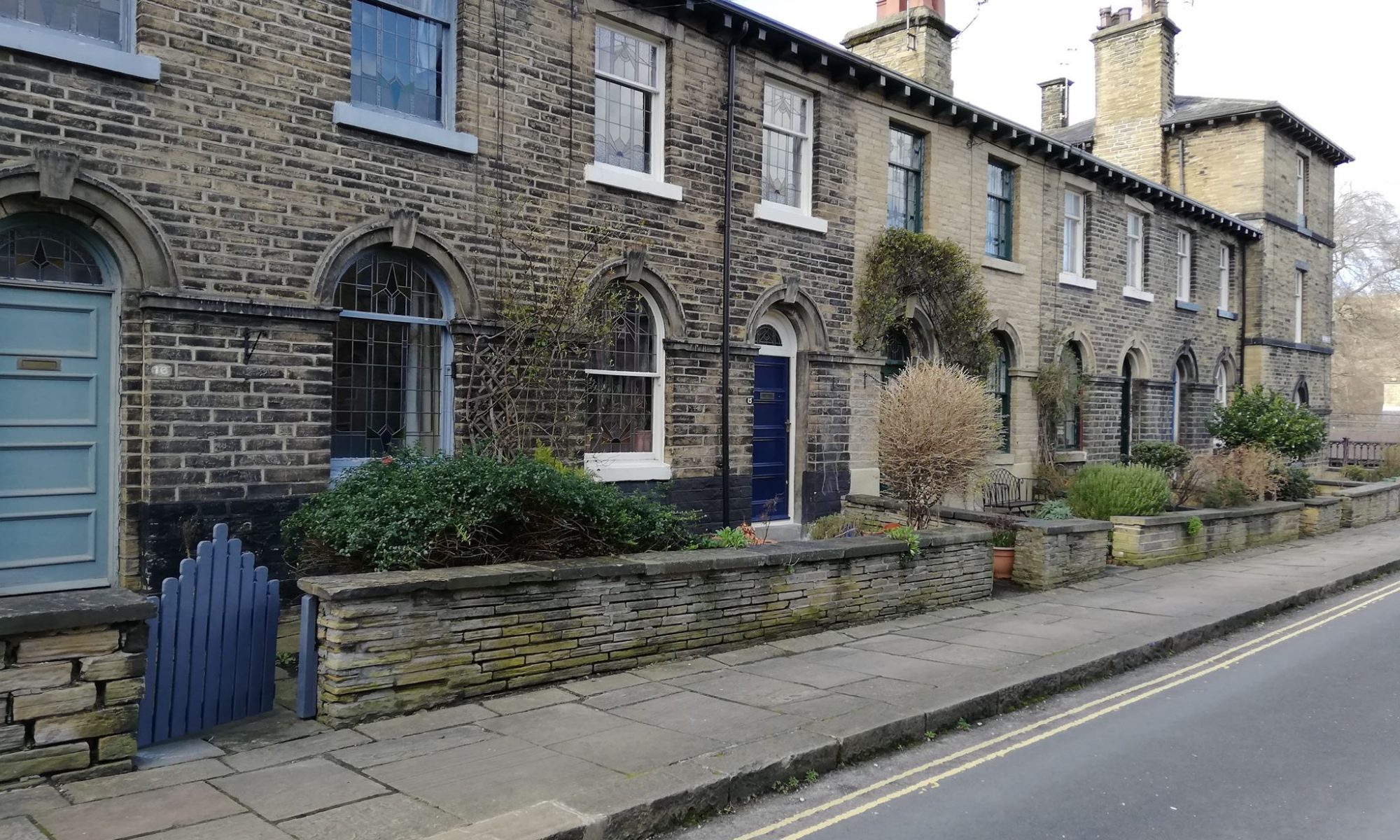
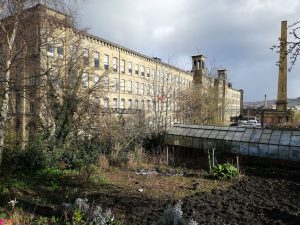
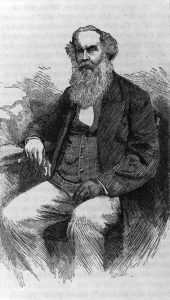 Saltaire was built in 1851 by Sir Titus Salt, a leading industrialist in the Yorkshire woollen industry. Salt was a cloth manufacturer who took over his father’s textile business in 1833 and expanded it over a period of twenty years to be the largest employer in Bradford. He was an alderman and then mayor of Bradford, and was elected to Parliament in 1848. Salt’s business was spread between five different mills, and with business booming, he decided to build a new mill, consolidating his operations into one place.
Saltaire was built in 1851 by Sir Titus Salt, a leading industrialist in the Yorkshire woollen industry. Salt was a cloth manufacturer who took over his father’s textile business in 1833 and expanded it over a period of twenty years to be the largest employer in Bradford. He was an alderman and then mayor of Bradford, and was elected to Parliament in 1848. Salt’s business was spread between five different mills, and with business booming, he decided to build a new mill, consolidating his operations into one place.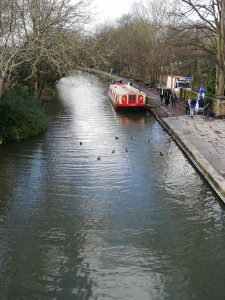 Salt, a deeply religious man, and a known philanthropist, was concerned about the over-crowded conditions in Bradford so bought land in Shipley, just outside Bradford, beside the River Aire, the Midland Railway and the Leeds and Liverpool Canal. Building began in 1851 and Saltaire Mills opened in 1853. To accommodate his workers, Salt then commissioned housing close to the mill. A model village grew up, which included well-built houses, a hospital, bathhouses, almshouses and churches. The Congregational church, now known as Saltaire United Reformed Church, was built at Salt’s own expense and he donated the land upon which the Wesleyan Chapel was built. With the moral improvement and probably the work performance of his workforce in mind, he forbade public houses or beer shops from the village. The village had a public institute which included a library, a reading room, a concert hall, billiard room, science laboratory and a gym. There was also a village school, a park, allotments and a boathouse.
Salt, a deeply religious man, and a known philanthropist, was concerned about the over-crowded conditions in Bradford so bought land in Shipley, just outside Bradford, beside the River Aire, the Midland Railway and the Leeds and Liverpool Canal. Building began in 1851 and Saltaire Mills opened in 1853. To accommodate his workers, Salt then commissioned housing close to the mill. A model village grew up, which included well-built houses, a hospital, bathhouses, almshouses and churches. The Congregational church, now known as Saltaire United Reformed Church, was built at Salt’s own expense and he donated the land upon which the Wesleyan Chapel was built. With the moral improvement and probably the work performance of his workforce in mind, he forbade public houses or beer shops from the village. The village had a public institute which included a library, a reading room, a concert hall, billiard room, science laboratory and a gym. There was also a village school, a park, allotments and a boathouse.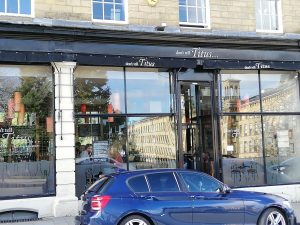 A surprising number of the original buildings survive, including the Institute which is now known as Victoria Hall, and the beautiful United Reformed Church. The houses are lived in and clearly much loved. Modern shops have moved in, and I was particularly entertained by a rather nice looking bar and restaurant, imaginatively called “Don’t Tell Titus” in reference to the founder’s refusal to allow alcohol to be sold anywhere in the village.
A surprising number of the original buildings survive, including the Institute which is now known as Victoria Hall, and the beautiful United Reformed Church. The houses are lived in and clearly much loved. Modern shops have moved in, and I was particularly entertained by a rather nice looking bar and restaurant, imaginatively called “Don’t Tell Titus” in reference to the founder’s refusal to allow alcohol to be sold anywhere in the village.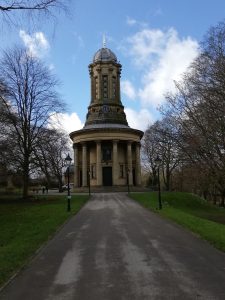

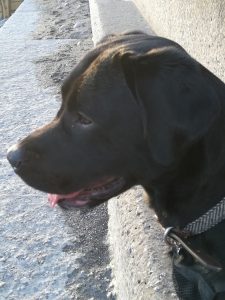 Good weather gave us the chance for a beautiful walk in the south of the island. Oscar was on the lead for most of the way, but was able to have a couple of off-lead runs which he loves. I have to tell you in advance that he was a VERY GOOD BOY today.
Good weather gave us the chance for a beautiful walk in the south of the island. Oscar was on the lead for most of the way, but was able to have a couple of off-lead runs which he loves. I have to tell you in advance that he was a VERY GOOD BOY today.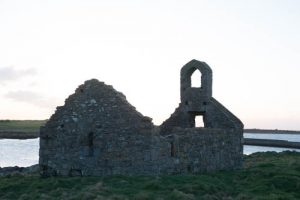
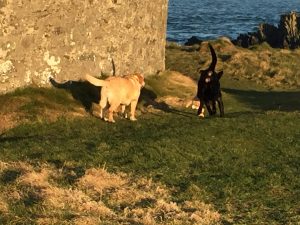
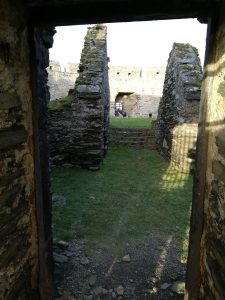
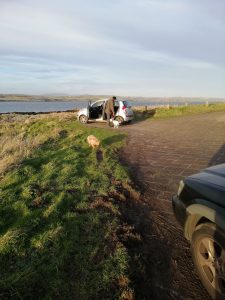 “Whew, that was fun. They’re not youngsters, those two, but they could run. Although that one waddled a bit like old Joey. Where now?”
“Whew, that was fun. They’re not youngsters, those two, but they could run. Although that one waddled a bit like old Joey. Where now?” “Ruined. No, that’s King William’s College. It’s the only public school on the island. Which really means it’s a private school, because you have to pay to go there. I’ve never really understood that.”
“Ruined. No, that’s King William’s College. It’s the only public school on the island. Which really means it’s a private school, because you have to pay to go there. I’ve never really understood that.”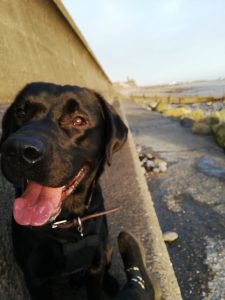 “Can I go on the beach?”
“Can I go on the beach?”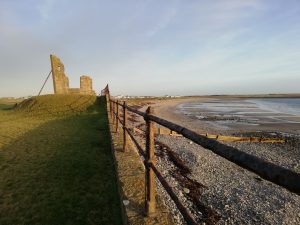 “Ooh. What’s that?”
“Ooh. What’s that?”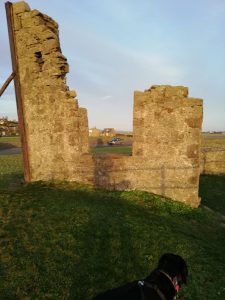 Hango Hill is a small mound by the side of the coast road between Castletown and Derbyhaven, overlooking the beach. It was possibly an ancient burial site and a Bronze Age flat axe was apparently discovered there. The name derives from the Norse words for Gallows Hill and was used as a place of execution until the seventeenth or possibly early eighteenth century.
Hango Hill is a small mound by the side of the coast road between Castletown and Derbyhaven, overlooking the beach. It was possibly an ancient burial site and a Bronze Age flat axe was apparently discovered there. The name derives from the Norse words for Gallows Hill and was used as a place of execution until the seventeenth or possibly early eighteenth century.
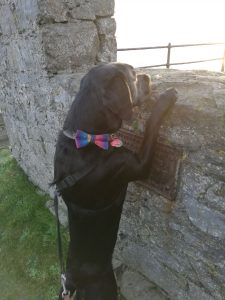
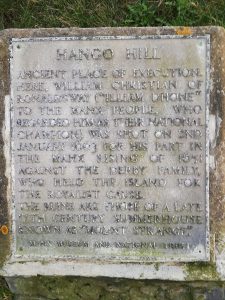 “It’s just a little bit about the history of the place and Illiam Dhone. Each year, on the anniversary of his death, they have a gathering here and make a speech in the Manx language.”
“It’s just a little bit about the history of the place and Illiam Dhone. Each year, on the anniversary of his death, they have a gathering here and make a speech in the Manx language.”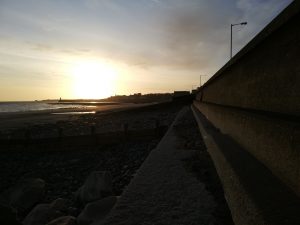 “It is. The light’s starting to fade as well, I forget how early it gets dark. Right, back to the car then, we’ll be warmer if we’re walking.”
“It is. The light’s starting to fade as well, I forget how early it gets dark. Right, back to the car then, we’ll be warmer if we’re walking.”